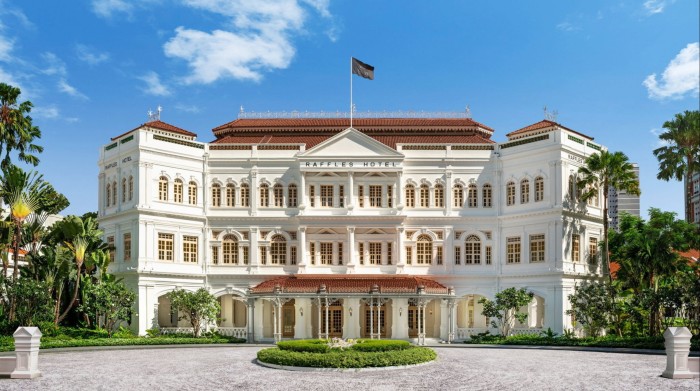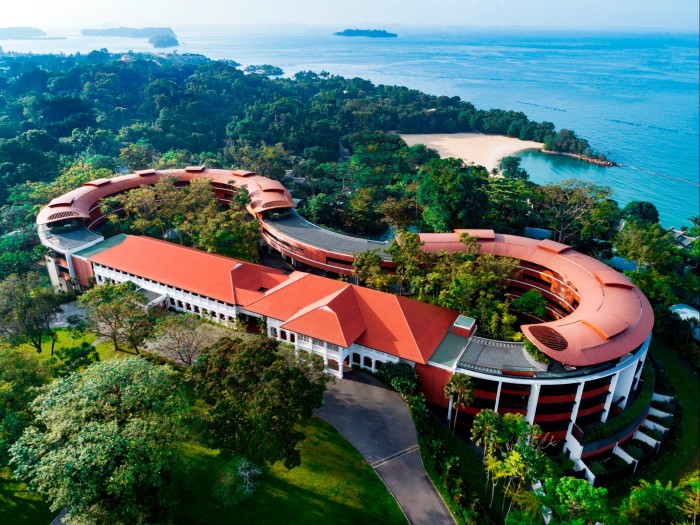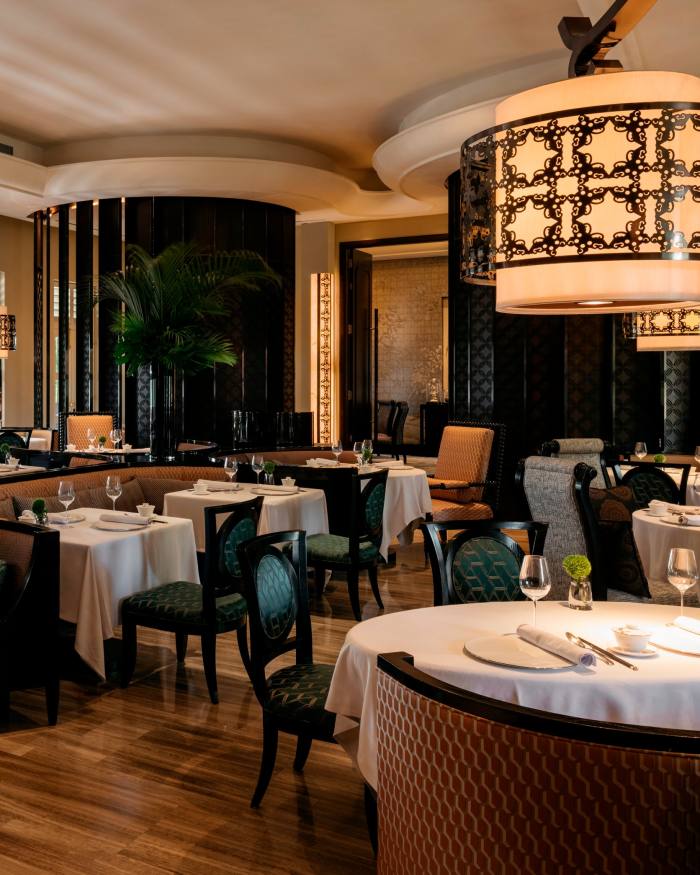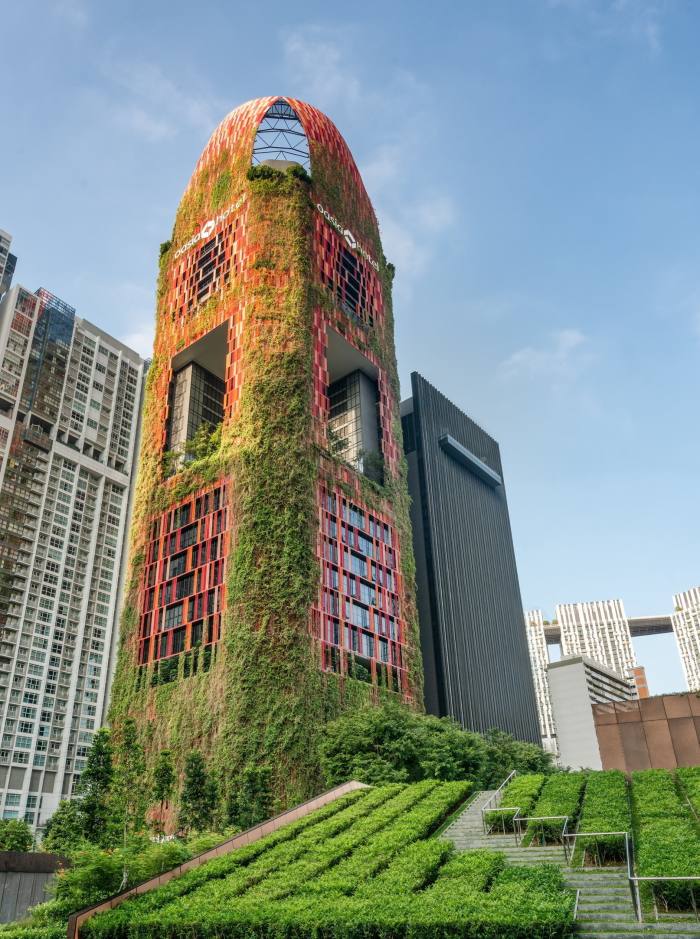This article is part of a guide to Singapore from FT Globetrotter
For almost five years, I lived a commuter’s life between London and Singapore. In the Lion City I had a house to lay my head in, but work often required me to road-test hotels both new and established, and I was asked by friends often enough for recommendations that I kept my finger on the pulse of who was doing what, where. Now that I’m no longer a local, Singapore’s hotels feature more holistically in my experience of the city; based on what I’m travelling for (work, friends, a stopover I need to cram both into), I care about neighbourhood, size, vibe and service. (Ah, service in Singapore. Still occasionally a bit of a blip issue . . .)
The good news is the hotel scene seems to be evolving into something befitting the size and sophistication of Singapore. An Edition, a Mondrian and a Standard are all in the pipeline — youthful brands with high design and reputations for plugging ably into local scenes. And Raffles is set to plant a second Singapore flag on Sentosa Island later this year. So whether you’re after a deep-dive into the cocktail-bar scene or a poolside loll followed by a Michelin-starred dinner, there will soon be more choice than ever. Meanwhile, here is a selection from among the city’s very best options, for different agendas.
For the bucket list: Raffles
1 Beach Road, Singapore 189673

The USP: Its heritage. From the name (taken from Singapore’s colonial founder, Sir Stamford Raffles) to the Long Bar (welcoming peanut shell-chucking expats since the early 1900s), it’s one of south-east Asia’s most storied hostelries, a semaphore in white stucco for the Lion City’s British East Indies history. In 2017-19 it underwent a total renovation by New York-based designer Alexandra Champalimaud, and while some of the public spaces gleam almost unrecognisably with slick new finishes and crystal lights, the overall Raffles gentility is still intact.


The rooms: There are 115, and thanks to the building’s generous proportions, the most modest (about 500 sq ft) puts rooms that call themselves suites in other hotels to shame. Champalimaud’s intervention was, cleverly, minimal. A few choice furnishings have been updated from ’80s staid to 21st-century low-slung: spacious armoires gleam with polished metal and leather linings; pretty encaustic tiles adorn the bathrooms. But the original hardwood floors remain, as do the lazily spinning ceiling fans and four-poster beds. And the long, shared verandas are, blissfully, still long and shared.


Food and drink: A smorgasbord of destination tables, many of which are primarily the preserve of tourists and businesspeople. You can still throw peanut shells at the now quite gussied-up Long Bar, but the Writers Bar next to the lobby, with its tryst-ready corners, is the chicer drinks venue. Take the constituents you need to impress to Anne-Sophie Pic’s stellar La Dame de Pic or to Yì, where Jereme Leung does very haute Chinese cuisine. Refined primi piatti and Super Tuscan reds are served at Alain Ducasse’s cheery Italian, Osteria BBR, formerly the hotel’s Bar & Billiards Room. But for my money, the most fun is to be had at Butcher’s Block, where Hawaiian chef Jordan Keao does brilliant, kind-of-Hawaiian, kind-of-Asian things with both meat and veg in his open kitchens.
Spa: A gorgeous one in the Raffles Arcade, a three-minute meander from reception.
Gym: Yes — it’s not huge, but serviceable, with personal training available.
Rates: Double, from S$1,300 (about £795)
For the CEO with family in tow: Shangri-La Singapore
22 Orange Grove Road, Singapore 258350
The USPs: Space, service and extreme family-friendliness.
More of a small citadel than a hotel, the flagship Shangri-La comprises the Tower, Garden and Valley Wings. The pool is truly enormous; the 15 acres of landscaping are mature and lovely; the Garden Wing’s terraces overflow with pink bougainvillea. There are space-, safari-, castle-, underwater-, treetop- and space-themed suites for the tots. But there are also concierges to service any and all business needs, from cars to translators — as well as an excellent Club Lounge, and some of the speediest butler service I’ve ever had.
The rooms: Besides those themed kiddie suites, design-wise things are fairly straightforward, if also comfortable. The Tower Wing rooms are spare and a bit monochrome, but well configured for work, with large desks (often set in a window, so you face out to the view), plenty of outlets and good lighting. The bathrooms are smallish but good, clad in marble and dark wood. For longer stays, the Horizon Club Junior suites are like little apartments, complete with slick kitchenettes and dining areas.


Food and drink: As at Raffles, the options here cut a wide swath, from Italian at Waterfall to sashimi at Nami to a sublime version of chicken rice — that staple of hawker centres — in the patrician Lobby Lounge that earned its not-so-hawker-centre price tag. Breakfast at The Line is a thing of wonder: a United Nations of regional specialities — nasi goreng, siu mai dumplings, bagels, Cronuts and every imaginable thing in between, spread across what feels like acres of counter and cart space.
Spa: One of the best in town, and a favourite of locals. Shangri-La’s Chi brand is well established, and this one is a hushed, private enclave done with low lighting and lots of warm wood and colour.
Gym: Yes, with row upon row of Life Fitness aerobic machines. A bonus: the hotel’s two outdoor tennis courts.
Rates: Double, from S$380 (about £230)
For the coolhunter: The Warehouse Hotel
320 Havelock Road, Singapore 169628

The USPs: A colonial “godown” (warehouse) that eventually became a disco, which became the first hospitality project of local restaurant impresario Wee Teng Wen (whose Lo & Behold group counts some of the city’s finest drinking and dining venues in its portfolio), The Warehouse is, for now anyway, Singapore’s design hotel par excellence. Local firms Zarch Collaboratives and Asylum recast the old spaces with clever lighting, lots of smoothed concrete and some post-industrial-vibes beams and metalwork.
The location, right across the river from Robertson Quay, is ideal for foodies (there’s a plethora of good eats within walking distance, from high-end Neapolitan pizza to old-school chilli crab), runners and walkers (the river paths, which run all the way to Marina Bay, are great for otter-spotting), and anyone who wants a change from the touristic Orchard or Beach Roads, or the CBD, Singapore’s business and financial district.

The rooms: Understated, minimal but not cold, and very clever in how they leverage space. All 37 rooms and suites have elegant freestanding units variously combining wardrobe, workspace, storage and minibars. Floors are smooth timber; bedding is soft and cozy; bathrooms have big showers and generous sink space — even the very compact Warehouse Sanctuaries, the smallest room category. The River View Mezzanine has a soaring ceiling and tons of natural light; the River View suite is a single-level loft, with a sexy open-plan bathroom.

Food and drink: The Lobby Bar is also the lounge and reception in one unstructured space — but it works, with a sunken bar along one wall and long, low butterscotch-leather sofas arranged in seating areas along the room’s perimeter; it’s a great place to invite friends to start off an evening. Po, the small restaurant adjacent to the lobby, elevates heritage and home-cooking traditions — in this case, Singapore’s own. Delicious, carby Asian comfort food.
Spa: No
Gym: No, but there is a small rooftop pool.
Rates: Double, from S$404 (about £250)
For the heritage buff: Maxwell Reserve
2 Cook Street, Singapore 078857

The USPs: Maxwell Reserve, housed in a century-old British colonial-administration building, started out in 2019 as one half of the Six Senses Singapore, which retired the management account in 2020; the other half, Duxton Reserve, now comes, like Maxwell, under Marriott’s Autograph Collection. The three-storey building sits at the border of Chinatown and Tanjong Pagar, two of Singapore’s culturally and architecturally most interesting neighbourhoods (the latter also one of its nightlife hubs — you’re in striking distance of some of the city’s buzziest cocktail bars and restaurants, as well as the Maxwell Food Centre, reliably good for all sorts of hawker specialities).

The rooms: All 138 were designed by Jacques Garcia, so are heavy on jewel tones, velvet, Persian rugs and passementerie. The 160 sq ft Petit Club rooms are compact, but perfect for a solo traveller, with alcove beds framed in a peacock-feather jacquard fabric and plenty of daylight. The Junior Club and Salon Club suites have multiple windows and generous separate seating areas. The minibars, stocked with small-batch spirits, craft aperitifs and gorgeous mixing kit, are a win.

Food and drink: Several on-site options, including an Indian restaurant, Shikar, and a steak house called the Officer’s Mess Polo Bar, as well an almost outré jewel-box drinking establishment, Isabel, with a backlit pink-onyx bar and yet more red velvet (fun for the ’gram addicts, perhaps). But the fact is, in this neighbourhood you’ll probably be eating elsewhere.
Spa: No, but there is an outdoor rooftop lap pool.
Gym: Yes, small but serviceable.
Rates: S$420 (about £255)
For the escapist (with cash to spare): Capella Singapore
1 The Knolls, Sentosa Island, Singapore 098297
The USPs: Island-idyll feels; marquee-name architecture; serious luxury.

Set on the south-west side of Sentosa Island, about a 20-minute taxi ride from the CBD (on a good-traffic day), this was the first Capella hotel to open, 14 years ago. Sentosa is home to golf courses, yacht clubs, and an integrated resort or two; there’s a Disney-esque vibe to much of the island, but there are also quite lovely parts, where dense greenery gives way to South China Sea views, imparting passable island-holiday vibes. The Capella, on a nicely landscaped hill, enjoys one of the best vantages, in two late 19th-century Tanah Merah colonial barracks joined by a sinuous extension courtesy of Foster + Partners. No wonder it’s a staycation favourite — it very much says “resort” rather than hotel.

The rooms: Capella is a five-star enterprise all the way, and this is reflected in the design. Entry-level rooms are long, large and softly contemporary, with gleaming timber floors and picture windows overlooking the water (usually dotted with supertankers, but still). The suites carry the design over into bigger spaces with separate sitting areas, while 38 villas take it into serviced private-residence dimensions, all with plunge pools and terraces. Three manor houses — two colonial, one contemporary — offer the full Monty: multiple en suite bedrooms, dining rooms, cook’s kitchens and their own pools and terraces.


Food and drink: What you’d expect at a place of this calibre, ranging from Fiamma (a new Italian overseen by star chef Mauro Colagreco) and Cassia (contemporary Chinese, in a stunning room designed by Andre Fu) to Bob’s Bar, which capitalises on the resort’s prime sundowner position with outdoor seating.
Spa: Yes — the Auriga spa, a multi-award-winner that offers Biologique Recherche facials and a daunting number of combination-treatment Wellness Journeys (with attendant price tags).
Gym: Also excellent, all Technogym aerobic equipment, full weight circuits, and personal trainers by appointment.
Rates: Double, from S$1,600 (about £980)
For those famous Singapore views: The Fullerton Bay Hotel
80 Collyer Quay, Singapore 049326
The USPs: A centre-of-the-action location on Collyer Quay; fast, polished service; proximity to the CBD.


The ace in Fullerton Bay’s pocket is arguably its situation: overlooking Raffles Place, the Singapore Flyer big wheel and the three infinity-pool-crowned towers of the Marina Bay Sands hotel-casino complex (you could stay there, but trust me — it’s better to wonder at the spectacle from these coordinates). It happens to also be a lovely hotel: modern, full of light, with elegant interiors by Andre Fu and a youthful staff who’ve always impressed during my various stays. And there are few better places to catch the nightly Spectra light and water show than from a table at Lantern, the Fullerton Bay’s rooftop bar. It’s an easy 10-minute walk to Marina Bay Sands and its gargantuan shopping mall offering (which runs the gamut from Céline to Din Tai Fung), and a further 10 minutes to the weirdly wonderful Gardens By The Bay. The CBD is an easy walk in the other direction.

The rooms: They do the job, in the best possible way. The entry-level double is more than 450 sq ft, with clever sliding partitions separating the bathroom from the bedroom, for enjoying the views while you soak in the tub. Every one of them has a well-provisioned work area and a small separate sitting area. The windows throughout the hotel are floor-to-ceiling, so light is a USP all day. A few of the Bay View rooms have terraces with Jacuzzis. Design throughout is what you might call subtle contemporary pan-Asian: glossy hardwood details, hits of bold-hued silk, lots of orchids.

Food and drink: Breakfast is served in La Brasserie, a pretty double-height space at ground level that’s also open for lunch and dinner. With its more than 200 covers, The Clifford Pier, the hotel’s heritage lobby restaurant, is vast, though pretty; and there’s an equally attractive afternoon tea with views served at The Landing Point. But Lantern and its views are probably the winner here, given how easy your access is from the Fullerton Bay to many of Sing’s favourite eateries in Tanjong Pagar and Telok Ayer (another easy, if occasionally sweaty, 10 or 15-minute walk).
Gym: Yes, full service, and a 25m lap pool on the hotel’s roof.
Spa: Not on site, but guests have booking privileges at the spa at the Fullerton Hotel, about a 10-minute walk up Fullerton Road.
Rates: Double, from S$901 (about £550)
For the budget savvy: Oasia Hotel Downtown
100 Peck Seah Street, Singapore 079333
The USPs: A CBD-meets-Chinatown location; value for money; cool architecture creds.

WOHA is one of Singapore’s most laurelled architecture firms, having designed local rapid-transit stations, luxury resorts on Bali and even a university campus in Bangladesh. And the Oasia is one of the most distinctive buildings on the Singapore skyline, thanks to its striking combination of bright-red aluminium mesh cladding and lush green vertical plantings, evidencing a full 21 different species. Three interior “verandas” — entire floors given over to outdoor space — create additional bio-havens (the green “quantum” WOHA has achieved here is tantamount to requirements for 10 whole buildings). This means two outdoor pools, plus a yoga lawn — all many storeys above the city.

Rooms and suites: Nice clean lines and lots of light wood, minimal frippery — the basics you need (a good bed; a wall-mounted TV with lots of channels; a small but serviceable work space; natural light; bathtubs in the Club rooms), and not much you don’t. The views-for-days from most of them are a bonus.

Food and drink: There’s all-day simple dining at The Marmalade Pantry, on the hotel’s ground floor (think salads and sweet-potato fries, a handful of pastas and fancy sandwiches), which is where hotel guests eat breakfast. OSO Ristorante, while not part of the actual hotel, is a haute Italian-leaning venue on the tower’s 27th floor. Along with nice sharing plates of cheese and salumi (and caviar, if it’s your thing), there’s an extensive entrée menu that’s very carnivore-friendly.
Gym: Yes — like the rooms, compact and not complicated, but with what you need: treadmills, ellipticals, weights and room for stretching. Weekly yoga classes are complimentary (though first come, first served).
Spa: None, but staff can recommend local day spas for treatments.
Rates: Double, from S$284 (about £170).
Tell us about your favourite place to stay in Singapore in the comments
Follow FT Globetrotter on Instagram at @FTGlobetrotter




